Defense & Security
Fears and concerns of russians
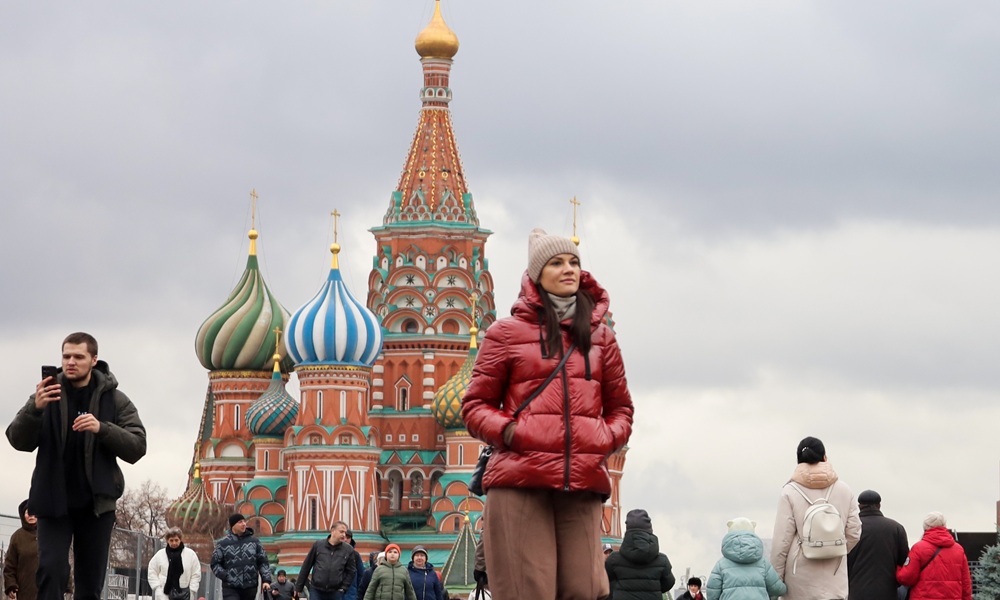
Image Source : Shutterstock
Subscribe to our weekly newsletters for free
If you want to subscribe to World & New World Newsletter, please enter
your e-mail
Defense & Security

Image Source : Shutterstock
First Published in: Oct.20,2025
Oct.20, 2025
If you ask the average person in any country about their concerns, their answers would likely be very similar. Across the globe, people are generally most worried about the uncertainty of the future, particularly regarding their finances. This holds true whether you're in the United States, China, or elsewhere. However, does this trend remain the same for a country in a state of war?
2014: The Sochi Olympics & The Annexation of Crimea
The year 2014 was significant for Russia, both economically and politically. It was marked by two major events: the Sochi Winter Olympics and the annexation of Crimea.
The 2014 Winter Olympics were held in Sochi, a Russian resort city. To host the games, the government spent an enormous amount of money, over $50 billion, on transportation infrastructure and new sports complexes. In recent decades, the Olympics have been seen as a way for nations to exert "soft power," and there were even speculations in 2010 that Russia may have paid its way to host the games. Despite the celebration of the event's successful conclusion, this period was immediately followed by a major political decision.
During late 2013 and early 2014, Ukraine's internal political situation was highly unstable. Many Ukrainians were unhappy with their pro-Russian government's policies, believing that President Yanukovych was a "Russian puppet" who had denied the country a chance to join the European Union. Yanukovych's suspension of a key pact with the EU sparked mass protests and eventually a revolution.
While the world's attention was focused on the Olympics and the political turmoil in Ukraine, Russia swiftly moved its troops into the Crimean Peninsula. With military and political pressure, the Crimean government held a referendum, after which the majority of citizens voted to join Russia. This move led to massive international sanctions against Russia, which put its rapidly rising economy under immense pressure.
Russian Concerns in 2014
This period of political and economic pressure was reflected in the concerns of ordinary Russians. According to a Levada Center survey from May 2014, the top concerns for Russians were:
Illness or death of relatives
Poverty or job loss
World war
Crime
Political repression
Public humiliation
Health threats
However, the trends in these fears showed some notable changes compared to the previous decade (1999–2014).
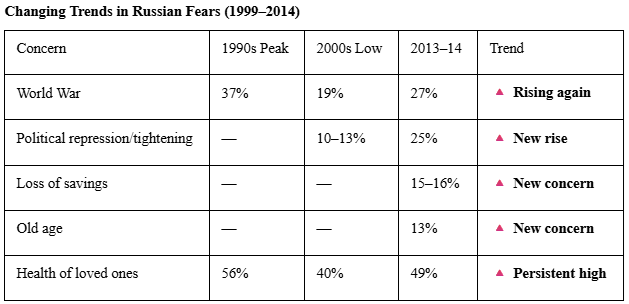
Excluding health concerns, these trends indicate that Russians became increasingly worried about the country's political and economic situation. The fear of war also increased due to the instability in Ukraine and the repercussions of their president's actions on the lives of ordinary citizens.
2018-2019: The World Cup, Pension Reform, and Shifting Public Concerns
The period of 2018 to 2019 was a abundant in all the aspects time for Russia, marked by a contrast between a successful international event and a significant domestic political turmoil. The main events of this year were the presidential election, the FIFA World Cup, and a highly questionable reform.
Political Discontent and Public Protests
In the run up to the 2018 presidential election, Vladimir Putin, in order to secure his presidential spot banned all possible candidates from joining the race. One of the prominent opponents of Putin was Alexey Navalny, who was massively supported by younger generation. Along with allegations of widespread election fraud and a controversial pension reform, it acted as a major catalyst for public protests. Critics argued that with a low average life expectancy (66 years for men), many Russians would not live long enough to collect their state pensions.
These events, combined with a documentary by Navalny’s Anti-Corruption Foundation exposing government corruption, fueled significant public demonstrations and damaged government’s image. Tens of thousands of people across Russia joined in these protests, leading to a major surge in political anxiety. Authorities responded with a lockdown, arresting many participants and detaining even more people. Educational institutions reportedly pressured students to not participate, threatening them with dismissal. Navalny himself was repeatedly arrested.
Despite the size of protest, there were no results, nothing has changed.
The Impact of the FIFA World Cup
In stark contrast to the domestic political turmoil, the 2018 World Cup provided the government with a platform for soft power and a temporary boost in national image. While not considered an economic success, and costing over $14 billion with a minor economic benefit, the tournament significantly increased global attention on Russia. This international spotlight, along with a more stable economic situation, created a sense of national pride and momentarily overshadowed the public's grievances.
Changing Public Fears (2014 vs. 2019)
Data from the Levada Center highlights how Russians' concerns shifted between 2014 - 2019. The two periods show a marked increase in fears related to political instability and government repression.
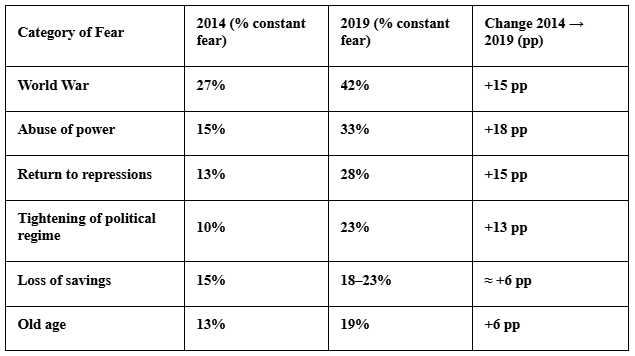
The most significant changes were in political concerns. The fear of "abuse of power" saw the largest jump, increasing by 18 percentage points to 33%. Along with the fear of a "return to repression" and a "tightening of the political regime", which increased by 15 pp and 13 pp, respectively. These statistics underscore a growing public distrust and disbelief in the government, fueled by the 2018 pension reform, “rigged” election and protests. As an expert, Denis Volkov, explained, "People decided that the authorities violated their obligations, deceived them," which directly links the pension reform to the surge in political anxiety.
Despite these growing fears, a different Levada poll from late 2019 showed a slight increase in confidence in the government. This could be attributed to the successful staging of the World Cup and a powerful state propaganda campaign aimed at "reconciling people with reality." However, the long-term trends clearly indicate a population increasingly concerned with their political rights, personal freedom and security.
2025: Economic Struggles and New Public Restrictions
Following the full-scale invasion of Ukraine in February 2022, Russia has faced harsh sanctions and economic challenges. While the government has responded with tight control over public discourse, these policies and their consequences have significantly altered the concerns of ordinary citizens.
Russian public opinion has evolved throughout the conflict. Initially, there was a surge of patriotic sentiment, but as the war continued, public anxieties have shifted. While the fear of war remains a concern, the focus has increasingly moved toward domestic issues, such as the economy and social tensions. 2025 polls indicated that a majority of Russians supported peace negotiations to end the war, rather than continuing military action. This change is likely correlated with a growing economic impact of the war, as well as drone attacks and their damage on Russian territory, which brought the conflict’s sclale closer to home for many of Russians.
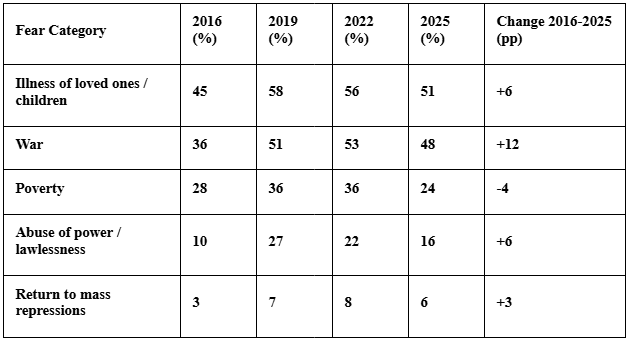
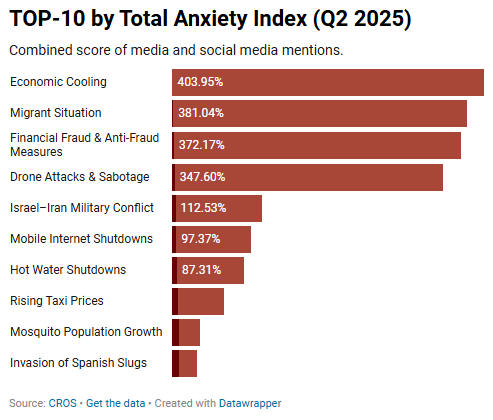
Economic and Social Concerns
Economic stability has long been a top concern for Russians, and the current situation has only amplified these fears. Since the invasion, government spending on the military has skyrocketed, leading to a massive budget deficit. In an effort to stabilize the economy and combat rapid inflation, the Central Bank, under the leadership of Elvira Nabiullina, implemented a policy of extremely high interest rates, at one point reaching 21%. While this was a logical, albeit painful, economic maneuver to slow down inflation, it had a harsh effect on ordinary citizens, making things like mortgages and loans prohibitively expensive. This has led to a major rise in public concern over the country's economic future, with a significant portion of the population now worried about the state of the "cold" or stagnant economy.
Another major concern is the issue of immigrant labor. Russia's aging population and the war have created a severe labor shortage, which is being filled by migrant workers, primarily men from Central Asian countries. These migrants often take low-paying, difficult jobs that Russians are unwilling to do. Despite their essential role in the economy, particularly in industries like construction, their presence has led to social tensions. Public fear, often fueled by nationalist sentiment and concerns over crime, remains a major issue. While some younger Russians may be more tolerant, the general atmosphere is a complex mix of necessity and xenophobia.
Public Restrictions and Digital Isolation
The government has also tightened its control over public life and information. Laws restricting dissent and free speech have escalated, with hundreds of people being jailed under new repressive measures. Many journalists and activists have fled the country, and critical discussion is now largely impossible.
A major part of this ban has been on internet and digital communication. Following the 2022 invasion, many social media platforms left Russia, forcing users to rely on VPNs to access sites like Instagram and Facebook. Further restrictions have been implemented, including limitations on popular messaging apps like WhatsApp and Telegram. These measures were officially justified as a way to minimize fraud, but they have also been seen as a way to promote state-sponsored apps and control communication. For many Russians, especially the youth, this digital isolation has become a significant source of frustration, with reports of internet slowdowns and service outages becoming more common.
How these concerns differ within age groups?
While many fears are shared across generations, their intensity and focus vary significantly by age.
For all age groups, the fear of illness of loved ones remains the strongest emotional anchor, symbolizing the dominance of private, family-centered values in contemporary Russian life. Additionally, the fear of war unites all age brackets, suggesting a collective awareness of geopolitical instability and the lasting psychological effects of military conflict.
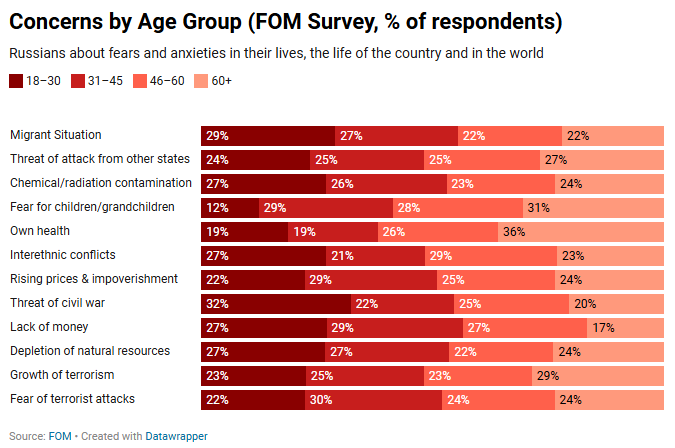
Generational Patterns
Recent data [1] reveals distinct generational patterns of fear and anxiety. While most citizens share concerns about security, stability, and well-being, the intensity and content of these fears vary sharply across age groups.
Younger Russians (18–30) display the highest levels of anxiety about political instability and future uncertainty. Nearly one-third fear a civil war (32%), and about the same proportion express concern about migration (29%) and environmental threats (27%). These fears reflect their heightened sensitivity to social unrest and global crises, likely influenced by online political discourse.
Middle-aged groups (31–60) tend to focus more on economic and social pressures. Concerns about rising prices and impoverishment (up to 29%), interethnic conflicts (29%), and terrorist threats (30%) dominate their worldview. This generation, responsible for families and careers, appears most affected by inflation, inequality, and the broader sense of insecurity in everyday life.
In contrast, older respondents (60 and above) prioritize personal health and family safety over political or economic fears. For this group, the focus shifts inward, from collective or national threats to the vulnerabilities of aging and declining health.
This progression from systemic to personal anxieties suggests that as individuals age, their fears become less ideological and more existential, mirroring the broader transformation of Russian society.
Conclusion
Over the past decade, Russian fears have evolved with political shocks, economic turbulence, and social change, yet in many ways, they remain strikingly universal. Like people in most countries, Russians fear illness, poverty, and war above all else. What distinguishes Russia is not the content of its fears, but the context that amplifies them: authoritarian governance, prolonged sanctions, and ongoing conflict.
The 2014 annexation of Crimea, the 2018 protests, and the 2022-25 wartime restrictions each reshaped the emotional landscape of Russian society. Political repression and economic instability deepened existing anxieties, turning collective uncertainty into a defining feature of everyday life. Still, beneath these structural pressures, the same human concerns remain love for family, fear of loss, and hope for security.
Ultimately, Russia is not an exception, but a reflection of the modern world: a nation where political fear overlays universal human vulnerability, and where personal and national uncertainty continues to define what it means to live in the 2020s.
Note
[1] It is important to acknowledge that the FOM is a state-funded organization, and the accuracy of its results may be subject to scrutiny.
First published in :
World & New World Journal

Unlock articles by signing up or logging in.
Become a member for unrestricted reading!